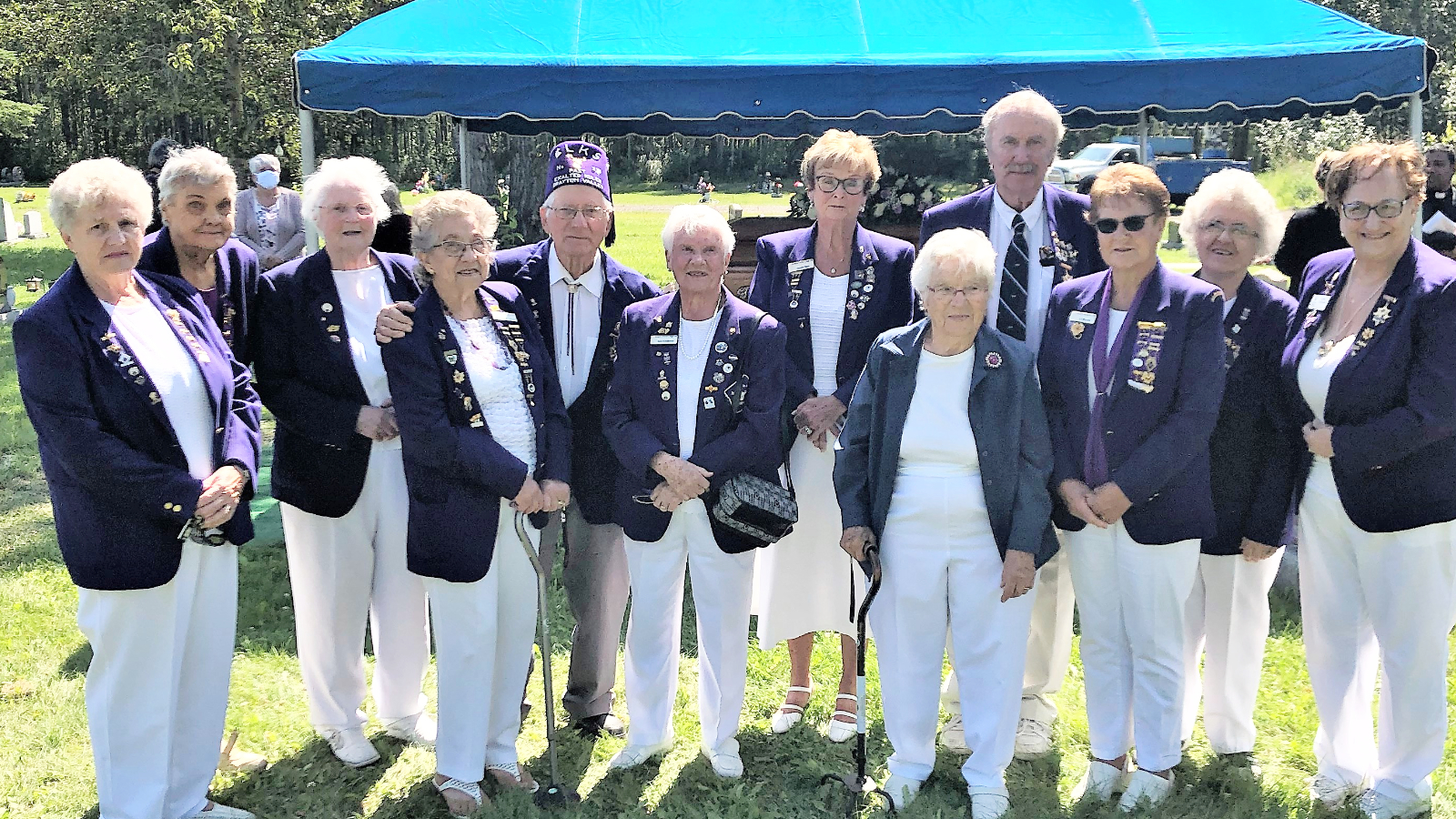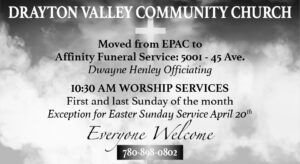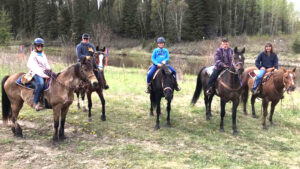Submitted Lil Mayhew
The Drayton Valley Royal Purple has surrendered its charter after 65 years in the community. Here’s a look back at the group’s history of service in Drayton Valley.
On March 18, 1956, twenty ladies met in the banquet room of the Drayton Valley Hotel to be installed, by Supreme Lodge, as the charter members of the Drayton Valley Royal Purple Lodge #196. Election of officers was held and Dorothy Pickel became the first Honored Royal Lady. The Elks had, already, been formed.
We were given 60 days, following our institution, to recruit new members, whose names would, also, be added to the charter. We initiated 4 new members, in April, and had two ladies transfer to us, from Spruce Grove Royal Purple (Lady Rand and Lady McMorris). Nine more ladies joined us in May. Our charter contains the names of these 35 ladies, as follows:
Dorothy Pickell Marge Gallant Helen J. Casson
Enid Seibert Gerry Weston Margot Meier
Blanche Watson Mary Burrows Joyce Fraser
Marjorie Hoyle Vivian Sand Marge Creelman
Betty Trollope Dorothy Rattray Valerie Fraser
Connie Humphrey Lesle Hamilton Joan Machan
Eunice Dennis Donna Sweinson Donalda Smith
Cecelia MacKenzie Shirley Tolchard Ester Davidson
Phyllis Redl Helen Leschenko Eunice Lebick
Jean Roberts Ethel Gregory Hilda Rand
Peggy McDonald Jeanne Reed Gladys McMorris
Vivian Peterson Madge Wall
Soon, members came in bunches…seven in November and fourteen on November 19. Our highest membership was in 1959, when we had 65 members on our roster. We had a whopping 75 percent increase in membership our second year!!!
We held one meeting per month for the first year, but found that two were needed, as we had become very busy in the community. Two meetings were held every month from 1957 to 2005, and were busy years. Our meeting place was the Community Hall, until Oct of 1957, when we moved to the Scout Hall, and paid $7.50 per meeting. In the fall of 1958, we moved back to the old Community Hall, which had been purchased by the Elks. In February of 1974, we began to hear rumblings of a new Elks Hall…and Block’s Store (owned by Hamdon Hamdon) became our new hall. This building was our home until June 1, 2004, when it was sold to Life Church.
In January 1965, the St. Anthony School opened its doors. Now, 60 years later, the school is planning a celebration of the milestone.
Principal Janelle Molzan says they are planning to have a celebration on May 24 at the school gym. They will be using the event to also fundraise for the school.
Molzan says they will have a band performing that evening, catering from a local restaurant, a full cash bar, as well as some door prizes.
Part of the celebration will also be the fact that St. Thomas Aquinas Roman Catholic School Division has put St. Anthony at the top of their priority list for a new school. Molzan says the division has to wait until next year to submit their request to the Province, and there is no guarantee that they will be selected for funding.
“It could be anywhere from two to ten years,” she says. “Or more.”
However, she feels that St. Anthony has a strong case for asking for a new school.
The most recent remodel of the school was in 1992, says Molzan. At that point they expanded the school, removing the gym from the centre of the school and installing classrooms instead. The new gym was then built as an addition to the school.
“We had the addition of the gym as well as a few classrooms in 1992,” says Molzan.
Since then, there have been no major remodels or renovations. Instead, the staff have been doing what they can to keep the building in shape.
“It’s a really well built school,” says Molzan.
She says over the years, the natural heaves and settling that occur with temperature fluctuations has led to some cosmetic damages to the building. “It’s just showing its age,” she says.
While the school is starting to show wear, Molzan says there are no capacity issues. About 15 years ago, the school went from being a K-12 school to a K-8 school when the Holy Trinity Academy was built.
Molzan says if they don’t get a new school they will have to pursue getting more renovations or remodeling for the current building.
New trespassing program helps businesses
Businesses will now have another option for dealing with trespassers thanks to a new program that Enforcement Services have put into place.
Cody Rossing, the manager of enforcement services and emergency management for the Town, says one of the biggest challenges for businesses in the community who were issuing trespass notices is that someone has to attend court in order for the trespassing charge to stick. With the new Trespassing Agent program which comes into place on March 20, businesses who enrol will not have to attend court.
Previously, businesses who contacted the RCMP to report a trespasser had to issue the trespass notices themselves.
For many businesses the process didn’t work well. Larger franchises, like banks, found arranging the issue of a trespass notice and attending court was not logistically feasible. Small business owners, on the other hand, could issue the notice but may have to close their business in order to attend court.
Rossing says there are two different pieces of legislation that speak to trespassing, the Petty Trespass Act and the Trespass to Premises Act.
“Under both of the legislations, the property owner or their agent are required to provide trespass notices, help get people off of their land, and stuff like that,” says Rossing.
The first offence fine under the provincial legislation is normally $600, but it could be up to $10,000. A second offence could have a fine of up to $25,000
The higher fines come into place when the individual ignores the notice and returns to the property. If the trespasser returns three times, the officers can then issue a summons to court. If they fail to attend, a warrant is issued, and at that point if they are found guilty, the higher fines can be given.
Rossing says the program is helping streamline the process for businesses. If they choose to enrol in the program, it will allow peace officers or the RCMP to act as their agent and issue the notices. It also means the business owners won’t have to attend court.
“Court is scary for a lot of people, and we understand that,” says Rossing.
The purpose of the program is to improve the process because officers are continuing to get calls to the same place over and over and business owners or their employees are uncomfortable with the court process. Until now, there hasn’t been any way to address those issues.
“It’s been a lot of work on the back end because there is no follow up process in place and there is no trespass notice being issued,” says Rossing.
He says the hope is that by having this program in place, businesses can sign up and they can begin to address the issue more efficiently.
Several different municipalities in the province have a similar program in place, says Rossing. While developing the program, Rossing did research on other initiatives and reached out to other municipalities that had something similar in place. He says he wanted to be sure that he had everything in place before he announced the program in the community.
There are also checks and balances that have been worked into the program.
“If you’re trespassed from a local business, one of our officers shows up and says you’re trespassed for six months, if you don’t agree with it, you can appeal that process,” says Rossing.
He says there is also the option for the business owners to speak with the officer and reduce the amount of time the individual is trespassed for. In some cases, if the RCMP issue a notice that’s in effect for six months, a business owner may come forward and advocate for the trespasser if the individual doesn’t normally behave in that manner
“They can say, ‘This person is normally a good customer, but there is something going on with him right now. I think maybe a month would be more appropriate,’” says Rossing.
However, it is ultimately the final discretion of the officer.
Once a business is enrolled in the program, they will receive a sticker that they can place in a conspicuous area that is easily visible for officers. If they receive a call, the officer will know that they can issue the notice themselves rather than speaking to the owner and explaining the process that has to take place.
Rossing says enrolment in the program is free, and he encourages businesses to sign up if they are having consistent issues with people loitering or being a nuisance on their property. Those who are interested in enrolling can visit www.draytonvalley.ca/enforcementservices/trespassingagent and fill out the form. They can then email it in to enforcement@draytonvalley.ca or drop it off at the Town office.
Technology bring collisions into focus
There are approximately 187 accidents in town each year within Town limits. That’s according to data from Drayton Valley Enforcement Services.
Cody Rossing, the Manager of Enforcement Services and Emergency Management for the Town, says data from 2016-2023 has helped map out intersections in the community that sees the highest number of collisions. The intersection at 50 Street North and Hwy 22 has had eight collisions, the highest in the community. The second highest number was at the intersection of 50 Street and 50 Avenue.
“Anything along Highway 22, the Town doesn’t have jurisdiction over, pertaining to road designs or changes,” says Rossing.
He says getting the data from the Province regarding collisions along Highway 22 is something they haven’t been able to do before. Now that they have the data they can start mapping out the high incident intersections and starting brainstorming ways they can address some of the problem areas. Rossing says those areas will have more focus from the community peace officers.
Rossing says they are trying to develop strategies on how to reduce collisions in the community on a whole, particularly those that result in fatalities.
“There’s different things we can use like engineering and controls,” says Rossing. “But for enforcement services, how are we strategically educating and enforcing in those areas?”
He says there are a number of factors that can contribute to collisions. Over the past eight years there have been 434 caused from unsafe speeds, 245 were intersection related, 163 that are weather related, 114 from road surface conditions, 51 involving animals, and 417 were from drivers performing improper actions.
With speed being the most prominent cause, enforcement services have been taking action to find out where speeding is most common and increasing patrols. The digital speed signs that were purchased with funds from the Community Safety Committee don’t have cameras on them, but they do record the speed and report that data back to enforcement services.
On March 6, officers intercepted a vehicle driving 102 km per hour in a 50 km zone.
“That vehicle was pulled over, a court summons was issued to the driver to compel them to court. If they don’t attend court a warrant will be issued for them,” says Rossing.
If they are found guilty, they could face a fine of up to $2,000 and/or a license suspension.
Rossing says anyone who is over the speed limit by more than 51 km per hour will face an automatic court summons.
This was not the only incident of speeding. On March 5, the digital speed signs picked up on a vehicle driving 111 km per hour in a 60 km per hour zone. They also pulled over a vehicle going 50 km per hour over the limit that same day.
“That is strictly within the Town of Drayton Valley boundaries,” says Rossing.
There are a number of reports enforcement services can get from the digital signs, including the amount of traffic on a road and the times that see the most traffic. Using this data, enforcement services can ensure they deploy units during the busiest times of the day to the areas where speeding is common.
What you see is what you get
Like William Shatner, Mike Myers, Wayne Gretzky’s dad and God help us, Celine Dion, here at the Free Press, we are Canadian.
There’s been a lot of talk recently about US ownership of some of this country’s most prominent businesses and institutions. At the Free Press we are certainly not prominent, nor do we want to be institutionalized. But still, it seems like a good time to point out to anyone who’s interested, that we are exactly what we appear to be.
We are 100 percent locally owned. There are no hidden shareholders or outside interests. All of our staff live in either Drayton Valley or Brazeau County, apart from our designer, Brittany. She’s from here, but currently telecommutes from somewhere in British Columbia, which I have to confess, makes me a little jealous sometimes.
What else can I tell you? The Free Press is printed for us by some nice people in St. Albert. The printing press is owned by Great West Newspapers, which is also a Canadian company.
The paper we’re printed on comes from the Alberta Newsprint Corporation in Whitecourt. Incidentally, the paper is made from offcuts and waste from the lumber industry so we’re not cutting down trees to make the paper.
Once the paper has been printed it’s picked up and brought back to town by Drayton Valley’s own Rocket Express. At that point it’s back to us as we deliver it throughout the community.
Now you may be wondering why I’m telling you all this. Would the Americans really be interested in owning a tiny little paper in a small town in Alberta?
Well, you’d be surprised. A good chunk of Canada’s print media is currently in American hands, and that includes a number of community newspapers in this province. Postmedia is 66 percent owned by Chatham Asset Management, a hedge fund based in New Jersey. Who are Postmedia? They are the owners of the National Post, the Calgary Herald, the Edmonton Journal, the Calgary Sun, the Edmonton Sun and a host of other newspapers, both large and small, from coast to coast.
That situation may not be quite as bad as it sounds. I was the editor of the Drayton Valley Western Review (kids, ask your grandparents) for 10 years. During my time there the paper was owned by a succession of large, soulless corporations based in central Canada. They did absolutely nothing to impact the way we covered the news. I barely heard a peep in over a decade. I always suspected that was less to do with high journalistic standards at corporate headquarters, and more down to the fact they were only dimly aware we existed and probably couldn’t find Drayton Valley on a map, but either way the effect was the same.
So corporate ownership, whether it’s American or not, probably isn’t the best thing ever, but it isn’t necessarily fatal to Canadian news.
But I do think there’s an important distinction between a paper like the Free Press and some of the others; and it’s this. If you take out a subscription or buy an advertisement with us you can be confident that your money is staying close to home. And especially these days, that seems like a good investment.
Local auctioneer takes the championship
A local auctioneer has chanted his way into the history books after securing himself a first place position at the 2025 Canadian All Around Auctioneer Championship.
Prior to the 2025 CAAAC, Justin Mayer had already earned a trophy at the 2020 Canadian Bid Catching Competition. He is the first to hold a title for both competitions.
Mayer, at 29-years-old, says he’s been participating in the CAAAC for more than a decade. His mentors and many of the auctioneers he grew up listening to have all competed in the competition and some have won.
“It’s a pretty prestigious award,” says Mayer.
A good auctioneer is someone who can present themselves in a professional manner, with confidence in your body language and hand gestures. They have to be well spoken and comfortable with public speaking. The auctioneer chant, which requires rhythm, clarity, and speed to be considered such, is also an important technique that auctioneers must master.
“You should be able to almost dance to an auctioneer’s chant,” says Mayer
When he entered the CAAAC, Mayer participated in two rounds. The preliminary round ruled out everyone except for the top five. Those five then moved onto the final round.
In both rounds, five judges ranked their skills on a scorecard, and the person with the best overall ranking took home the award.
Mayer is not the first member of his family to take home the CAAAC title. His uncle Ron Sekura also held the title, and for Mayer, that makes the win even sweeter.
“He’s passed on, so it’s pretty cool for me to have the title with him,” says Mayer.
As a kid, Mayer was surrounded by some of his biggest mentors in the auctioneering world. His uncle, stepfather Corey Sekura, and grandfather, Wendell Sekura, all encouraged his love of auctioning.
He says he loves the sport because of the high energy atmosphere and the chance to meet people.
“When you’re up on the stand in front of the crowd selling, it’s up to me to present, in lots of cases, people’s livelihoods and their entire life, whether you’re selling a farm or a disbursement sale. It’s up to you, as the auctioneer, to generate excitement and do your homework in front of the crowd in order to bring top dollar for people,” says Mayer.
Over the years, Mayer has met many people and he says he enjoys the connections
“I know somebody from every town,” he says.
Now that he’s taken the title for the CAAAC, he is eligible for the International All Around Auctioneer Championship and from there he can head off to the World Championship.
For many, the decision to go to the international championship would be easy, but Mayer says he’s not sure what he’s going to do.
“I grew up in an auction family, and for me and my family to win this competition was a big deal,” says Mayer. “Now that I’ve won it, I kind of feel like I achieved what I wanted.”
However, Mayer has been receiving encouragement from Rob Bergevin, a Canadian International and Worlds competitor, to go to the International Championship.
“I beat him this year and he’s really trying to convince me to go to the International because he thinks I have a shot at it,” says Mayer.
Mayer’s love of auctioneering resulted in him going to Western College of Auctioneering in Billings, Montana in 2013. Since then, he’s been building up his reputation as an auctioneer across Alberta and British Columbia.
He says his uncle and stepfather were always in his ear, pointing out areas where he could do better and giving him advice to improve his skill.
“Grandpa Wendy was a big factor in that as well,” says Mayer.
For several years, Mayer spent a lot of time travelling to municipalities across the province and British Columbia to local auctions. However, once the pandemic hit, many auction houses opted for online auctions as a way to still run the business while meeting government regulations. Since that time, it’s not uncommon for auctions to be held online.
“But I still travel around,” says Mayer. “I still do lots of auctions. I’m never going to stop. It’s too exciting.”
Over the years, Mayer has worked for Team Auctions, as well as auctioning off classic cars. He also works for a lot of charity auctions.
When his children were younger, they struggled with the amount of time that Mayer was away. Now that they’re older, he says they appreciate it more. His daughter has even been asking for lessons, and has been practicing reading off a list of numbers that she has on her wall.
Mayer says he’s grateful to everyone for their support and encouragement over the years.
“I’m tremendously thankful to my mom, my dad, the Sekura family, my wife and my kids. They have all been there for me. They’ve all shaped me,” says Mayer. “Probably my biggest influence in all of it was my Uncle Ron, and my dad, Corey. They really shaped me and supported me.”
Charter school proposal moving forward
Members of local indigenous groups are working toward opening a charter school with the goal of offering students an education that goes beyond academics.
Charlene Bearhead, a member of the board for the Roots of Resilience not-for-profit society, says the group is applying to the Minister of Education to be able to open a charter school in Drayton Valley, with a goal of opening in September.
The society is hosting an information night on February 13 from 5-7:30 p.m. at the Holiday Inn Express.
Bearhead says her 40 years of working in education has made it clear that the system is failing children and staff as human beings.
“I’m always a big believer in doing the best you can to try to work with what exists already and do what you can to help guide that,” says Bearhead.
She worked within the system, and recently served as a school board trustee, but she says people weren’t ready to progress with changes she feels need to be made.
The goal of opening the charter school is to offer a learning experience that encompasses a child’s entire wellbeing, including mental and spiritual health, along with teaching Alberta’s curriculum. While the students will learn from methods that indigenous people have always used for passing on knowledge, Bearhead says the school isn’t just open to indigenous children. Any child in the area from Kindergarten to grade 12 will be welcome to attend.
One thing that Bearhead wants the public to be aware of regarding charter schools is that they are still public schools. Roots of Resilience will be funded in the same manner that Wild Rose School Division and the St. Thomas Aquinas Roman Catholic School Division are.
“One lady said to me, ‘This sounds so amazing Charlene, but I really struggle with anything that takes away from public schools,’” says Bearhead. “I had to say to her ‘This is public education. This is public school.’”
She says there are only provisions for charter schools in Alberta. Charter schools receive the same funding for facilities, transportations, and other expenses, and the same requirements to follow the Alberta curriculum and the Education Act. Just like any other public school, parents do not have to pay extra to enrol their children in a charter school.
“But they are intended to be schools of choice,” says Bearhead. “They give parents and kids a choice in their education.”
However, charter schools are not without controversy. According to the website of Alberta Teachers’ Association, “there is only one pot of money for schools in Alberta. When money is diverted to private and charter schools, it leaves public schools in a funding shortfall.”
Bearhead says charter schools have to offer a unique approach to education that isn’t available in the geographic area. Bearhead says it’s important to the RoR society to define the holistic success for the school, which means the students will be doing better in body, mind, and soul, as well as academically.
She says that pushing people hard to do well academically while ignoring all other aspects of the student’s progress doesn’t work well. For Bearhead, it’s important for educators to meet the students where they’re at, value them as human beings, offer them a safe environment, and offer opportunities for the students to see themselves reflected in what is being taught.
Along with the regular curriculum, Bearhead says they plan to offer language programs for those who are interested in learning the language of their ancestors to help those students connect with their heritage.
Wendy Snow, the Interim District Captain in the Otipemisiwak Metis Government for District Eight and member of the RoR society, says she feels her own children would have benefitted from what the proposed school will be offering.
Snow says she has two children as well as a niece that she is the guardian of. With all three of them going to school in Drayton, she says they went to almost every school in the community.
“I found that it was very lacking as far as teaching to our culture,” says Snow.
She says every year she would fill out the demographic forms, indicating that her children were indigenous, knowing that the school division would get additional funding for those students.
“I found that all of the funding in the Wild Rose School Division went to Rocky Mountain House,” she says. “All the programming, all the culture stuff, everything went to Rocky Mountain House.”
Like Bearhead, Snow wanted to work with the system and try to help improve things. She ran twice for school board trustee, but did not get elected.
“I’ve always wanted to see more funding and programming and culture stuff in this area, just like there is in Rocky Mountain House,” says Snow.
Bearhead says the RoR school will resonate with indigenous children.
“An indigenous pedagogy, or approach to education, is about physical, mental, social, emotional, and spiritual [well-being]. Whatever that means to you. Everyone is indigenous to somewhere,” says Bearhead.
She says public charter schools are smaller and have unique approaches to education.
“They are actually intended to be models for how education could happen in any or all public schools,” she says.
Bearhead says when the students see themselves reflected in the content they’re learning, they have a better chance of relating to it and absorbing it.
By making the students the centre of the system, educators can focus on the whole child, not just the content they’re supposed to be learning. She says each student has different strengths, weaknesses, interests, and paths. In their school, they plan to help students excel at their strengths, offer support for their weaknesses, and encourage their interests and plans.
Another important part of education is offering the students a safe space.
“If kids are terrified, if kids are being bullied, if kids don’t feel safe, how can they focus on learning?” says Bearhead. “That’s just human instinct. That’s survival.”
She says if students are feeling ostracized, alienated, or left out, it’s more challenging for them to learn.
Roots of Resilience will also offer hands-on learning for students. This experiential learning will be land-based, which means there will be more of a balance between indoor and outdoor learning. She says there are many different areas of the curriculum that can be taught outdoors beyond science and physical education.
“For me, when you do something, rather than just read about it or hear about it, it becomes ingrained in you,” she says.
Snow says she wants to see children in the area have an opportunity to choose an education that best suits them.
“I think it just gives them a great basis for success later on in life,” says Snow.
Our first delegate to a Supreme Lodge Convention was Eileen Belva, who went to Kamloops in 1960.
Our Lodge was composed of very young ladies. Some were newly-weds and many had jobs and young children. With both home and work commitments, somehow, we always found time to attend meetings and to do tons of community work.
We have gone through a lot of ladies during our 65 years! 259 to be exact.
Over the years, our District No. and the Lodges within it have changed. We’ve had Ponoka, Gainsford, Entwistle, Wildwood, Edson, Jasper, Onoway, Warburg, Breton, Leduc, etc. Many of these closed, over the years, and now we are doing the same. Our membership is small and old.
Catering was our main money maker. Some of them were big affairs! In 1983 we did an outdoor catering, at a nearby farm, for 800 people, and catered to a High School Graduation Banquet to 600 guests. Soon after we were formed, we helped the Elks cater to a BBQ for 700 people for Drayton Valley’s 10th anniversary. We catered to provincial boxing meets, gun club shoots, rodeos, weddings, anniversaries, blood donor clinics, Wed night bingos, farmer’s markets, brunches and lunches. The bingos and Farmers Market caterings were weekly events for many, many years.
We were instrumental in many community projects. Gladys McMorris was our driving force in helping seniors. We organized the first senior citizens’ club, and even washed their windows when they acquired a building. We petitioned the town for a senior lodge, did tons of background work and cleaned the rooms for the contractor, when the Shangri-La Lodge opened in 1972. We promoted the establishment of the Wishing Well and Leizure Lea apartments for seniors, and participated in operating them until 1994, under the name “Purple Pansy Sr. Citizens Association”. We treated all seniors to a free turkey supper and entertainment, every Christmas, beginning in 1971- until 1990 when we had to quit because the number of seniors had outgrown the capacity of the Elks Hall. We initiated the Emergency Response System, for seniors, and assisted in its operation. We purchased a 4 wheeled scooter for use by seniors and paid for taxi service for seniors, one day per week. Funeral lunches for seniors were provided free.
Download your experience guide
Spending a weekend cycling the secondary highway in and around Brazeau County is one of the great outdoor activities that this region has to offer. Minutes outside of Drayton Valley you will find yourself on kilometers of highway that seem to continue to stretch West. Many of these highways go near small hamlets and communities in the area, they go into and come out of river valleys and on a clear day offer a beautiful view of the Rocky Mountains.
One such circuit is the DV100 century loop. This 100km route takes you west past farmlands and through lush boreal forests, and through the small communities and hamlets that mark the birth of Alberta’s oil and gas industry. It is a loop that can be done with speed or taken at a leisurely pace, offering snack and eatery stops along the way.

Day 1: Arrival, dinner
Arrive at hotel: When you stay at a Drayton Valley Hospitality and Tourism hotel or campground you support local tourism initiatives in Drayton Valley and Brazeau County.
Evening ride: Stretch your legs and do the 19 km ring road multipurpose trails to Rocky Rapids. Park your vehicle at the “Welcome to Drayton Valley” derricks at the south end of town and right across the street you will be on the trails. The route will take you straight out to the hamlet of Rocky Rapids where you can stop off at the Rocky Rapids store for a snack. The original building is located at the Drayton Valley museum.
Dinner: Did you know we have over 40 different restaurants in Drayton Valley? Look at our restaurant listing in this guide.
Ricochet Aquatic Centre: Take in the steamroom and the hot tub at the local swimming pool. The pool is open until 8:00 pm most nights and will get you ready for your big century ride tomorrow.
Day 2: The DIY DV100
Breakfast: Take in some breakfast at your hotel or head out to one of our great breakfast venues.
DIY DV100: The DV100 is a 100 kilometre route that travels secondary highways in Brazeau County. Along the route there are several spots you can stop to regroup, take in a photo and enjoy some food. Just out of town is the Poplar Ridge Store, this is your last stop to get any supplies until you reach the community of Lodgepole about about kilometre 40.
Arrive Lodgepole: this is a small hamlet that has a general store in the heart of town. Here you can grab a drink, and convenience store fare. There is also the hotel restaurant that is open 11-12:30 and 3-8 most days, there is also the Aud Spot for breakfast and lunch as a cash only option.
Heading out of Lodgepole towards Cynthia there are a few great photo opportunities as you crest a hill coming up from the Pembina River Valley. This is a slog of a climb but once you crest it is smooth sailing to Cynthia.
Near the Hamlet of Cynthia there is the ever popular Cyn City Saloon where you can get a beverage and a burger. Heading back towards Drayton Valley and Hwy 621 your next stop is 39 km away in the community of Rocky Rapids where you can stop at the store for some snacks and then back into town.
(In the Evening)
Hotel: regroup at your hotel and get ready for the evening.
Dinner: Drayton Valley has more than 40 different restaurants. Have a look at our listings page to decide where you want to eat.
Drinks: Head to a patio and enjoy the sunset with an ice cold brew. Lounge patios can be found at; Khal’s Steakhouse, Boston Pizza, Mitch’s Restaurant, Oil Country Tap House, Bourbon House and Mr. Mikes.

Day 3 Check out, walk and head home
Breakfast: Breakfast at your hotel or check out and head to a local restaurant for brunch.
Disc golf or a walk: If you want to stretch your time here in Drayton Valley, head over to Ivan To Park for a walk around the pond or a round of disc golf. The park has an 18-hole disc golf course that is open at no charge. If you’re pushed for time there’s an easy cut off to limit your round to 9 holes.
Head home. We hope you’ve enjoyed your time in our community. Come back soon!
Staff Sergeant Ryan Hoetmer says dealing with the effects of the homeless population in the community is not simple.
Hoetmer says that the most common complaint regarding homeless individuals is about them sleeping or spending time in business entrances. That was one of the main issues raised by town council in a discussion on September 18.
Hoetmer says RCMP involvement in removing the individual and charging them with trespassing is a bit tricky, especially in regards to private businesses.
“The police themselves do not make a determination of whether that homeless individual can be there or not,” says Hoetmer. “That has to be the business that decides that.”
This means that someone from the business has to contact the RCMP to let them know there is an unwanted individual in the vestibule. At that point, police can attend and get the individual moving along.
However, unless the business has served trespass notices on the person causing the issue, the RCMP cannot issue fines for trespassing.
That is also not as simple as it seems. Hoetmer says that does give the trespass notice has to be willing to pursue the entire process into court as well.
“They’ve got to show up at trial if this individual fights it,” he says.
Hoetmer says banks, for example, are not typically interested in pursuing this as they all have nationally run security headquarters, so there’s not a lot of interest in them following those steps.
Both the Town and RCMP have met with bank managers and are encouraging them to lock their doors at night to prevent the homeless from using the vestibule as a warming space.
Due to the lifestyle that comes with homelessness, which often includes mental health issues and addictions, the RCMP do interact with the homeless on a regular basis.
“We get to know these individuals, but unless they are commiting crime we don’t have a lot of power,” he says.
He says the Town has asked them to have more enforcement on homeless individuals who have been banned or issued trespassing notices.
“Our job is community safety so if that’s what the community wants to keep the community safe, we’ve agreed to do that,” says Hoetmer.
However, that means businesses need to start following through with the process on their end.
In regards to the Civic Centre vestibule, Hoetmer says the Town would need to start looking at trespassing individuals in order for the RCMP to begin issuing tickets.
“That is up to the Town whether they want to trespass these individuals from all Town property,” says Hoetmer.
But even with all of the businesses doing their part and the RCMP able to keep up with the enforcement, there is still more to consider.
“Enforcement has failed these individuals for years. Nobody usually becomes unsheltered without probably having had enforcement intervention for a number of years already, and it hasn’t changed anything.”
Hoetmer says there have been no complaints of physical harm caused to residents by any homeless individuals. “They can be aggressive and make people feel uncomfortable, but we have had no assaults. No reports of any sort of physical violence to anybody.”
In regards to break and enters, Hoetmer says some of the smaller property crimes are being committed by homeless individuals, but they aren’t the only ones.
“There’s other individuals in town that are not homeless that are committing those offences,” says Hoetmer. “The bigger break and enters are being committed by prolific property crime offenders.”
In regards to issuing fines for trespassing, Hoetmer says that also isn’t as simple as many believe. Those who have fines may not be able to pay them. At some point, they can be arrested, but there is no guaranteed timeline for how long the individual will stay behind bars, as they will be released first if room is needed for people convicted of more serious crimes.
In the end, the fines do not get paid.
Hoetmer says he doesn’t want the Town to “hang their hat on enforcement,” because while it can play a role in deterring homeless individuals from becoming a nuisance, it’s not the entire solution.
“We’re going to have a role,” says Hoetmer. “Our job is keeping the community safe. So, if part of that is needing to enforce, then we will do that.”
Drayton Valley high school students had the chance to listen to a first hand account of an indigenous woman whose life was drastically altered by the Sixties Scoop.
Michaela Lewis is now a student at SAIT, but her road there was long and arduous. She told the students that she is enrolled in the Film and Video Production program, which she plans to use to create a documentary about her life.
“It wasn’t just my family that I lost,” said Lewis. “It was my culture, my traditions, my language, my identity.”
Lewis’ mother, Bernice, gave birth to her in the spring of 1979 in the Edmonton General Hospital, and at the time was on her own. Bernice was married to a non-indigenous man, which meant that she and her children had lost their treaty rights. At the time of Lewis’ birth, the husband was in prison. Lewis was not his biological child.
Hospital staff told Bernice that she couldn’t raise a child on her own.
“The nurses and the hospital staff forced my mother into signing me away,” said Lewis.
She said her mother just went along with everything they told her to do because she felt like she had no other option. After she left the hospital, she went and got her other daughter before returning to the hospital to get Lewis.
When Bernice returned the next day, the staff told her that Lewis had been given to social services and that she had to deal with them. Lewis’ mother was given the run around by social services for several weeks before finally hearing that Lewis had died.
Instead, Lewis had been adopted out to a non-indigenous family. Social services also took her older sister from her mother.
“My older sister was lost to the system by the age of five,” says Lewis.
As a result of losing both of her children, Lewis’ mother turned to substances to cope and became an addict. For quite some time, her mother was homeless because there was no support system for her.
At 18 years-old, Lewis was able to unseal her adoption records and began to search for her family. Eventually, Lewis was reunited with her mother, stepfather, three sisters, brother, and a large extended family.
Lewis’ adopted mother had told her that “those native mothers, they left their unwanted babies in garbage cans and they were all alcoholics and addicts.” Lewis was even told she likely had fetal alcohol syndrome. It wasn’t until later that she found out that was not true. Bernice told Lewis that she hadn’t told anyone about Lewis because she thought that a nurse had ended Lewis’ life at the hospital after she had left her there.
Lewis was shocked as nurses were respected health care providers. She had been raised to believe there was a system in place that prevented such things. She began looking into the history and learned about the residential school system and all of the children who had been taken from their families.
Bernice told Lewis not to bother with trying to get justice because she would get nowhere. Her mother had been in the Bow Valley Residential School, and after learning of its history, Lewis understood why her mother had believed a nurse had killed Lewis.
Then, history repeated itself.
“My oldest son was taken from me when he was four-years-old,” said Lewis. “In that horrific moment, I completely understood why my mother lived the life that she did.”
At the time, Lewis was a single mother attending college to get her high school diploma. She had aspirations of becoming an interior designer.
When her son was five months old, his father left Lewis and later began stalking her. He threatened to take her son. Her adopted mother told her that if Lewis gave custody of her son to her adoptive mother, his father couldn’t take him and Lewis could still have the boy live with her.
“Desperate to keep my child, I agreed to it.”
Lewis was stressed out with everything going on, so her stepfather suggested she come back to live with them and finish her schooling with the support of her family. Lewis agreed and notified her adoptive mother of her move.
That was when her adoptive parents came and took her son.
“I didn’t even have a chance to have a say in court.”
Lewis became suicidal. She was unable to go back to school or get her job back and she spiraled, eventually becoming an addict.
“I’ve never in my life felt so broken, defeated, and alone,” she said.
It was her stepfather who helped her to heal and become sober. She says he was supportive and told her that she didn’t have to let the same thing happen to her that happened to her mother. After the conversation with her stepfather, Lewis began working to placate her adoptive parents so she could see her son.
Ten years after her son was taken, Lewis stood up to fight for her oldest son. When her second son was born in 2014, she told her adoptive parents that they wouldn’t keep her children apart. She regained custody of her son, and has been raising her youngest son since his birth.
Lewis said she is the first mother in several generations in her family, to have the opportunity to raise a child from birth.
Download your experience guide
Before there were clubs, and ultra lounges there was the rural bar. The rural bar was a place people would go to have a drink, eat some food, get a bit of news and maybe even get a haircut. The rural bar was usually built alongside or attached to the lone hotel in the community. These were the first restaurants and live music venues and a place where the community could gather.
For our rural watering hole tour we dug up six watering holes in the Brazeau and Beyond region that hold historical significance for the communities they operate in.
Our tour begins at the Drayton Valley Hotel. The Drayton Valley Hotel was built in 1954. It was the anchor for what would become downtown Drayton Valley. Before the Derrick Lounge became a centerpiece of the Drayton Valley Hotel, there were many different shops that occupied the bottom floor of the building including Rexall Drugs, a menswear store, the Royal Bank of Canada and a cafe. The cafe was located on the storefront with the lounge located off the street in the back.
“I remember in 1999 you had to walk through the cafe to get to the lounge and it was draft for $1,” recalls resident Graham Long.
The Derrick Lounge, named in honour of the industry that gave rise to the development of Drayton Valley. This is a watering hole best known for its Friday night karaoke.
Iron Wheel Inn and Tavern, Entwistle
42 KM, 25 Minutes
Just 25 minutes drive, 42 kilometers north of Drayton Valley is the Iron Wheel Inn and Tavern. The Iron Wheel is located in the heart of Entwistle. The Iron Wheel dates back to 1910 when the building was originally the Immigration Hall built near the Grand Trunk Railroad Station. Parts of the Grand Trunk bridge footings can still be seen at the Pembina River Provincial Park. When the “Moose” Munroe’s hotel was destroyed in a fire in 1919, his eye turned to the immigration hall which was no longer in use. Through a series of exchanges Munroe acquired the hall and began operating it as a hotel. In 1922 the hall was moved, in two parts, to the current location of the Iron Wheel Inn and Tavern where it remains to this day.
Gainford Hotel, Iron Lady Saloon, Gainford
15 KM, 9 minutes
Gainford is a tiny hamlet of 118 people in Parkland County. It is 86 km west of Edmonton on Highway 16 (Yellowhead Highway) and 18 km from Entwistle. The Gainford Hotel first opened its doors to welcome guests in 1958. In those days hotel guests were seismic and construction crews working in the area. As things changed the hotel became a stomping ground for university students heading out to Seba Beach for a hot summer weekend. The hotel closed in 2013 only to be revived a decade later. In 2023 the Iron Lady Saloon and Java and Gem Get Stuffed Restaurant opened their doors. The inside has a distinct western feel. There’s a traditional dark wood bar and billiards. Stuffed coyotes, lynx, rabbits, owls, and hawks still decorate the tavern walls from days gone by.
The Iron Lady Saloon is known for various Saturday night live music events.
Doggone Saloon, Tomahawk
25 KM, 17 minutes
Just a 17 minute drive from Gainford is the hamlet of Tomahawk. If you are looking for a rural watering hole experience this is as rural as it comes. The history of Tomahawk dates back to 1902. With the first mention of a hotel and cafe dating back 1909. The “Last Chance Cafe” was owned by John Kelly; it was described as a “shack right in the road,” by Mrs. Kelly in Tomahawk Trails. The cafe became known as the Last Chance Hotel. “Meals at all hours, people stayed there when they could stay at no place else. The door was open day or night whether he [Kelly] was home or not and people stayed as long as they wanted to,” Mrs. Kelly wrote. The hospitality in the area now belongs to the Doggone Saloon, in the middle of Tomahawk. The saloon is still a favorite stop for travelers passing by. Throughout the summer months motorcyclists riding Alberta’s scenic rural roads will stop off at the saloon for the patio and a refreshment.
The Village Golf Course, Lindale
21km 15 min
Honorable Mention: The lounge at the Village Golf Course is another stop you can add to your rural bar tour. The lounge is connected to the hotel and club house for the Village Golf Course. The lounge offers beverages and a food full menu.
The Breton Hotel and Bar, Breton
32 KM, 22 minutes
The Breton Hotel and Bar was built five years after the Lacome and Northwestern Railway came to the community. The hotel was built by William Spindler in 1931. In those days, like many other rural hotels and bars the Breton Hotel and Bar also had a barber shop. The decades that followed the 1930s, the bar had two entrances: one each for men and women. Over the years the hotel and bar was bought and sold many times with each new owner adding to or changing the design of the building. Joe and Katie Eluik purchased the hotel in 1964, at this time draft beer sold for 10 cents a glass, bottled beer was 30 cents and a case of beer could be bought for $2.50. The prices are not the only changes that happened, the separate entrances are no longer used, and the peaked roof in the original design has been redesigned as a flat top.
The Breton Hotel and Bar is still a fixture in downtown Breton.
Drayton’s Restaurant and Sports Lounge, Drayton Valley
48 KM, 34 minutes
Honorable Mention: As you meander back to Drayton Valley the Sports Lounge, attached to Drayton’s Restaurant is a worthy stop of this rural watering hole tour. The sports lounge has a distinct small town feel with billiards, friendly staff and a diverse menu. This is a place where you can unwind in the heart of Drayton Valley.
From the Sports Lounge you are just a block away from where you started at the Drayton Valley Hotel.
The old hotels, and bars that pepper our rural communities are linked to how the communities developed, and socialized in the down time between farming seasons, or at the end of a hard work day. They have a unique history that has evolved with the community and share in the community’s past and future.
Drayton Valley’s River Valley Players provided two well produced showcases for our local talent last weekend. Drayton Valley Has Talent 2024 junior and adult showcases were held the afternoon and evening of September 21 on the Pembina Stage of Eleanor Pickup Arts Centre in downtown Drayton Valley. The performances all benefited from full light and sound and the volunteer stage hands’ efficient handling of set changes.
Master of Ceremonies Leah Sanderson kept the evening on track and filled the space between acts with pleasant patter and some observational humour. Several rounds of “Happy Birthday to You” honoured those celebrating their special day.
With the last performer off stage, judge’s score sheets tabulated and result envelopes in the MC’s hand, audience drumrolls raised tension in the theatre as the winners were announced. The Junior results put Ella Rae’s performance of the Haley Joelle song, “Memory Lane” in third, Dandaline and Delilah Dusterhoft’s dance to “Daylight” in second, and the ventriloquism of Taylor Holman and her humourous puppets Rose, Grandma, a dog and a wise cracking, bacon loving goose first place. An audience favourite, Ms Holman’s performance sparkled with wit and laughs as her polished style and technique belied her years.
The adult category results placed Elvis performer Dustin Giesbrecht’s tribute to “Burning Love”, in third, and a performance of Keith Urban’s “Till Summer Comes Around” by Levi Eshleman in second. First place was awarded to an accomplished performance of the Liz Callaway song “Once Upon a December” from the Disney movie Anastasia. Claire Williams sung it with a sureness, intonation and presence that earned her the top spot.
Ayla Gartner, Ricky Bazar, John Dempster, and Melissa Wolf judged the performances. They were supportive and encouraging of the performers’ efforts and offered positive comments and suggested areas for growth.
Ashley Luckwell of RVP was grateful to the many local sponsors that made Drayton Valley Has Talent 2024 possible. “Being able to have two shows and have close to a full house in each meant we didn’t have to turn anyone away, audience or performers. It was wonderful!”
She was pleased with the generous spirit of the two audiences the showcase attracted and the great support they too gave to the junior and adult performers. “The audience’s support for the performers was amazing, very moving”, Luckwell commented. The audience came to the aid in a few performer’s faltering moments with cheers, applause and encouraging words.
Students may have a different learning experience this year after the Alberta Education Minister, Demetrios Nicolaides, made the call to ban cell phones in schools.
Brad Volkman, the superintendent of the Wild Rose School Division, says schools have until 2025 to create a policy regarding cell phone use, but they have to start implementing the ban in September.
Volkman says that for many schools, a ban on cell phones is business as usual.
“Quite frankly, many of our schools have already been doing that for years,” says Volkman.
However, cell phone policies have been left to individual schools to plan and implement. Now, the division itself needs to have something in place.
Volkman says division staff met with school staff to review the policy before the school year. He says the major points were that cell phones could not be used during learning time with the exception of those who have learning or medical needs that require the phones.
Right now, WRSD is using the time given to create their policy to test out different ways of implementing it and enforcing the rules. Each school is putting their own policies in place for the first month. After getting feedback from school staff, parents, and students, the division will be able to put together something that is effective and practical.
He says each school has a different approach to dealing with the phones. One approach requires students to leave their phones at the front of the classroom during instruction time. In some schools, students are required to leave their phones in their backpacks, or in others, teachers will confiscate phones if they catch their students using them.
“What we realized, and there is some research on this, is that we’ve got students that are probably addicted to their phone,” says Volkman. “The minute [the phones] buzz they have to look.”
Another important part of the ban on cell phones is also a ban on social media in the schools. The Minister’s directive doesn’t establish whether all social media needs to be blocked, or if it only applies to certain sites.
“Believe it or not, it’s up to the school division to decide which sites need to be blocked. They didn’t give us a list,” says Volkman.
Another area of the Minister’s order that isn’t very clear has to do with blocking the social media school-wide. The division is able to block the sites through their wifi, but they can’t block the sites for students who have data plans on their phones.
“The Minister’s Order doesn’t address that,” says Volkman. “The Minister’s Order says they can’t use their mobile devices during instructional time and it says that the networks that they connect to must block social media. But it doesn’t address anything around kids using their own data plans during breaks to access social media.”
Volkman says the division has been doing its best to implement the order while figuring out how to handle the effects that some of those implementations have had.
Right now, students are blocked from accessing social media via the school’s network. However, the staff are also blocked. This means that staff cannot use social media to update parents or advertise for upcoming events. As it stands, the division is unable to specify who may have access to social media and which social media needs to be blocked.
He says the division is working to find a way that will allow staff to communicate with parents and students while adhering to the Minister’s ban.
Volkman says the division’s policy will outline a progressive disciplinary plan for any infractions with cell phone use. He says it’s the same way they ask all of their schools to deal with transgressions.
“This will be no different than any other school policy or school rule,” he says. “You start easy, with understanding, grace, and education… but you do have to have a progressive style approach.”
Volkman says the goal is to have a draft put together by mid-October for stakeholders to review in November. In December, they will be putting the final touches on the policy so it is ready to be rolled out in the new year.
Lorem ipsum dolor sit amet, consectetur adipiscing elit. Ut elit tellus, luctus nec ullamcorper mattis, pulvinar dapibus leo.
Our philanthropy extended to all parts of the community. The schools were the recipients of help in many ways including bursaries, an auditory machine, books, lunch programs, Valentine Dances, etc.
The local hospital has received help, too. An incubator, baby car seats, adult crib and even a wringer/washer in 1957 are a few examples.
We donated to projects; Centennial Arena, Bus Association, a football field, and to every family, unfortunate enough to have lost their home by fire.
Lastly, we assisted the Elks, ( with whom we have always had a good working relationship) in their beautification of the hall with new drapes, stage redecoration, carpeting and kept the kitchen updated with the latest equipment including a commercial mixer.
Presently, we have a membership of 16, with an average age of 80.7 years. The four chair officers are:
Ethel Mankow (Honored Royal Lady)
Angeline Halushka (Associate Royal Lady)
Caroline Harrison(Loyal Lady)
Phyllis Landers (Lecturing Lady)
Other executive officers include: Lilly Mayhew (Secretary)
Betty Starling (Treasurer)
Reta Kenworthy (Conductress)
Morna Welch
“All in all”, we have had a wonderful, fruitful 65 years. We will miss our connection to the community and I’m sure we will be missed!
Download your experience guide
Spending a weekend cycling the secondary highway in and around Brazeau County is one of the great outdoor activities that this region has to offer. Minutes outside of Drayton Valley you will find yourself on kilometers of highway that seem to continue to stretch West. Many of these highways go near small hamlets and communities in the area, they go into and come out of river valleys and on a clear day offer a beautiful view of the Rocky Mountains.
One such circuit is the DV100 century loop. This 100km route takes you west past farmlands and through lush boreal forests, and through the small communities and hamlets that mark the birth of Alberta’s oil and gas industry. It is a loop that can be done with speed or taken at a leisurely pace, offering snack and eatery stops along the way.

Day 1: Arrival, dinner
Arrive at hotel: When you stay at a Drayton Valley Hospitality and Tourism hotel or campground you support local tourism initiatives in Drayton Valley and Brazeau County.
Evening ride: Stretch your legs and do the 19 km ring road multipurpose trails to Rocky Rapids. Park your vehicle at the “Welcome to Drayton Valley” derricks at the south end of town and right across the street you will be on the trails. The route will take you straight out to the hamlet of Rocky Rapids where you can stop off at the Rocky Rapids store for a snack. The original building is located at the Drayton Valley museum.
Dinner: Did you know we have over 40 different restaurants in Drayton Valley? Look at our restaurant listing in this guide.
Ricochet Aquatic Centre: Take in the steamroom and the hot tub at the local swimming pool. The pool is open until 8:00 pm most nights and will get you ready for your big century ride tomorrow.
Day 2: The DIY DV100
Breakfast: Take in some breakfast at your hotel or head out to one of our great breakfast venues.
DIY DV100: The DV100 is a 100 kilometre route that travels secondary highways in Brazeau County. Along the route there are several spots you can stop to regroup, take in a photo and enjoy some food. Just out of town is the Poplar Ridge Store, this is your last stop to get any supplies until you reach the community of Lodgepole about about kilometre 40.
Arrive Lodgepole: this is a small hamlet that has a general store in the heart of town. Here you can grab a drink, and convenience store fare. There is also the hotel restaurant that is open 11-12:30 and 3-8 most days, there is also the Aud Spot for breakfast and lunch as a cash only option.
Heading out of Lodgepole towards Cynthia there are a few great photo opportunities as you crest a hill coming up from the Pembina River Valley. This is a slog of a climb but once you crest it is smooth sailing to Cynthia.
Near the Hamlet of Cynthia there is the ever popular Cyn City Saloon where you can get a beverage and a burger. Heading back towards Drayton Valley and Hwy 621 your next stop is 39 km away in the community of Rocky Rapids where you can stop at the store for some snacks and then back into town.
(In the Evening)
Hotel: regroup at your hotel and get ready for the evening.
Dinner: Drayton Valley has more than 40 different restaurants. Have a look at our listings page to decide where you want to eat.
Drinks: Head to a patio and enjoy the sunset with an ice cold brew. Lounge patios can be found at; Khal’s Steakhouse, Boston Pizza, Mitch’s Restaurant, Oil Country Tap House, Bourbon House and Mr. Mikes.

Day 3 Check out, walk and head home
Breakfast: Breakfast at your hotel or check out and head to a local restaurant for brunch.
Disc golf or a walk: If you want to stretch your time here in Drayton Valley, head over to Ivan To Park for a walk around the pond or a round of disc golf. The park has an 18-hole disc golf course that is open at no charge. If you’re pushed for time there’s an easy cut off to limit your round to 9 holes.
Head home. We hope you’ve enjoyed your time in our community. Come back soon!
Staff Sergeant Ryan Hoetmer says dealing with the effects of the homeless population in the community is not simple.
Hoetmer says that the most common complaint regarding homeless individuals is about them sleeping or spending time in business entrances. That was one of the main issues raised by town council in a discussion on September 18.
Hoetmer says RCMP involvement in removing the individual and charging them with trespassing is a bit tricky, especially in regards to private businesses.
“The police themselves do not make a determination of whether that homeless individual can be there or not,” says Hoetmer. “That has to be the business that decides that.”
This means that someone from the business has to contact the RCMP to let them know there is an unwanted individual in the vestibule. At that point, police can attend and get the individual moving along.
However, unless the business has served trespass notices on the person causing the issue, the RCMP cannot issue fines for trespassing.
That is also not as simple as it seems. Hoetmer says that does give the trespass notice has to be willing to pursue the entire process into court as well.
“They’ve got to show up at trial if this individual fights it,” he says.
Hoetmer says banks, for example, are not typically interested in pursuing this as they all have nationally run security headquarters, so there’s not a lot of interest in them following those steps.
Both the Town and RCMP have met with bank managers and are encouraging them to lock their doors at night to prevent the homeless from using the vestibule as a warming space.
Due to the lifestyle that comes with homelessness, which often includes mental health issues and addictions, the RCMP do interact with the homeless on a regular basis.
“We get to know these individuals, but unless they are commiting crime we don’t have a lot of power,” he says.
He says the Town has asked them to have more enforcement on homeless individuals who have been banned or issued trespassing notices.
“Our job is community safety so if that’s what the community wants to keep the community safe, we’ve agreed to do that,” says Hoetmer.
However, that means businesses need to start following through with the process on their end.
In regards to the Civic Centre vestibule, Hoetmer says the Town would need to start looking at trespassing individuals in order for the RCMP to begin issuing tickets.
“That is up to the Town whether they want to trespass these individuals from all Town property,” says Hoetmer.
But even with all of the businesses doing their part and the RCMP able to keep up with the enforcement, there is still more to consider.
“Enforcement has failed these individuals for years. Nobody usually becomes unsheltered without probably having had enforcement intervention for a number of years already, and it hasn’t changed anything.”
Hoetmer says there have been no complaints of physical harm caused to residents by any homeless individuals. “They can be aggressive and make people feel uncomfortable, but we have had no assaults. No reports of any sort of physical violence to anybody.”
In regards to break and enters, Hoetmer says some of the smaller property crimes are being committed by homeless individuals, but they aren’t the only ones.
“There’s other individuals in town that are not homeless that are committing those offences,” says Hoetmer. “The bigger break and enters are being committed by prolific property crime offenders.”
In regards to issuing fines for trespassing, Hoetmer says that also isn’t as simple as many believe. Those who have fines may not be able to pay them. At some point, they can be arrested, but there is no guaranteed timeline for how long the individual will stay behind bars, as they will be released first if room is needed for people convicted of more serious crimes.
In the end, the fines do not get paid.
Hoetmer says he doesn’t want the Town to “hang their hat on enforcement,” because while it can play a role in deterring homeless individuals from becoming a nuisance, it’s not the entire solution.
“We’re going to have a role,” says Hoetmer. “Our job is keeping the community safe. So, if part of that is needing to enforce, then we will do that.”
Drayton Valley high school students had the chance to listen to a first hand account of an indigenous woman whose life was drastically altered by the Sixties Scoop.
Michaela Lewis is now a student at SAIT, but her road there was long and arduous. She told the students that she is enrolled in the Film and Video Production program, which she plans to use to create a documentary about her life.
“It wasn’t just my family that I lost,” said Lewis. “It was my culture, my traditions, my language, my identity.”
Lewis’ mother, Bernice, gave birth to her in the spring of 1979 in the Edmonton General Hospital, and at the time was on her own. Bernice was married to a non-indigenous man, which meant that she and her children had lost their treaty rights. At the time of Lewis’ birth, the husband was in prison. Lewis was not his biological child.
Hospital staff told Bernice that she couldn’t raise a child on her own.
“The nurses and the hospital staff forced my mother into signing me away,” said Lewis.
She said her mother just went along with everything they told her to do because she felt like she had no other option. After she left the hospital, she went and got her other daughter before returning to the hospital to get Lewis.
When Bernice returned the next day, the staff told her that Lewis had been given to social services and that she had to deal with them. Lewis’ mother was given the run around by social services for several weeks before finally hearing that Lewis had died.
Instead, Lewis had been adopted out to a non-indigenous family. Social services also took her older sister from her mother.
“My older sister was lost to the system by the age of five,” says Lewis.
As a result of losing both of her children, Lewis’ mother turned to substances to cope and became an addict. For quite some time, her mother was homeless because there was no support system for her.
At 18 years-old, Lewis was able to unseal her adoption records and began to search for her family. Eventually, Lewis was reunited with her mother, stepfather, three sisters, brother, and a large extended family.
Lewis’ adopted mother had told her that “those native mothers, they left their unwanted babies in garbage cans and they were all alcoholics and addicts.” Lewis was even told she likely had fetal alcohol syndrome. It wasn’t until later that she found out that was not true. Bernice told Lewis that she hadn’t told anyone about Lewis because she thought that a nurse had ended Lewis’ life at the hospital after she had left her there.
Lewis was shocked as nurses were respected health care providers. She had been raised to believe there was a system in place that prevented such things. She began looking into the history and learned about the residential school system and all of the children who had been taken from their families.
Bernice told Lewis not to bother with trying to get justice because she would get nowhere. Her mother had been in the Bow Valley Residential School, and after learning of its history, Lewis understood why her mother had believed a nurse had killed Lewis.
Then, history repeated itself.
“My oldest son was taken from me when he was four-years-old,” said Lewis. “In that horrific moment, I completely understood why my mother lived the life that she did.”
At the time, Lewis was a single mother attending college to get her high school diploma. She had aspirations of becoming an interior designer.
When her son was five months old, his father left Lewis and later began stalking her. He threatened to take her son. Her adopted mother told her that if Lewis gave custody of her son to her adoptive mother, his father couldn’t take him and Lewis could still have the boy live with her.
“Desperate to keep my child, I agreed to it.”
Lewis was stressed out with everything going on, so her stepfather suggested she come back to live with them and finish her schooling with the support of her family. Lewis agreed and notified her adoptive mother of her move.
That was when her adoptive parents came and took her son.
“I didn’t even have a chance to have a say in court.”
Lewis became suicidal. She was unable to go back to school or get her job back and she spiraled, eventually becoming an addict.
“I’ve never in my life felt so broken, defeated, and alone,” she said.
It was her stepfather who helped her to heal and become sober. She says he was supportive and told her that she didn’t have to let the same thing happen to her that happened to her mother. After the conversation with her stepfather, Lewis began working to placate her adoptive parents so she could see her son.
Ten years after her son was taken, Lewis stood up to fight for her oldest son. When her second son was born in 2014, she told her adoptive parents that they wouldn’t keep her children apart. She regained custody of her son, and has been raising her youngest son since his birth.
Lewis said she is the first mother in several generations in her family, to have the opportunity to raise a child from birth.
Download your experience guide
Before there were clubs, and ultra lounges there was the rural bar. The rural bar was a place people would go to have a drink, eat some food, get a bit of news and maybe even get a haircut. The rural bar was usually built alongside or attached to the lone hotel in the community. These were the first restaurants and live music venues and a place where the community could gather.
For our rural watering hole tour we dug up six watering holes in the Brazeau and Beyond region that hold historical significance for the communities they operate in.
Our tour begins at the Drayton Valley Hotel. The Drayton Valley Hotel was built in 1954. It was the anchor for what would become downtown Drayton Valley. Before the Derrick Lounge became a centerpiece of the Drayton Valley Hotel, there were many different shops that occupied the bottom floor of the building including Rexall Drugs, a menswear store, the Royal Bank of Canada and a cafe. The cafe was located on the storefront with the lounge located off the street in the back.
“I remember in 1999 you had to walk through the cafe to get to the lounge and it was draft for $1,” recalls resident Graham Long.
The Derrick Lounge, named in honour of the industry that gave rise to the development of Drayton Valley. This is a watering hole best known for its Friday night karaoke.
Iron Wheel Inn and Tavern, Entwistle
42 KM, 25 Minutes
Just 25 minutes drive, 42 kilometers north of Drayton Valley is the Iron Wheel Inn and Tavern. The Iron Wheel is located in the heart of Entwistle. The Iron Wheel dates back to 1910 when the building was originally the Immigration Hall built near the Grand Trunk Railroad Station. Parts of the Grand Trunk bridge footings can still be seen at the Pembina River Provincial Park. When the “Moose” Munroe’s hotel was destroyed in a fire in 1919, his eye turned to the immigration hall which was no longer in use. Through a series of exchanges Munroe acquired the hall and began operating it as a hotel. In 1922 the hall was moved, in two parts, to the current location of the Iron Wheel Inn and Tavern where it remains to this day.
Gainford Hotel, Iron Lady Saloon, Gainford
15 KM, 9 minutes
Gainford is a tiny hamlet of 118 people in Parkland County. It is 86 km west of Edmonton on Highway 16 (Yellowhead Highway) and 18 km from Entwistle. The Gainford Hotel first opened its doors to welcome guests in 1958. In those days hotel guests were seismic and construction crews working in the area. As things changed the hotel became a stomping ground for university students heading out to Seba Beach for a hot summer weekend. The hotel closed in 2013 only to be revived a decade later. In 2023 the Iron Lady Saloon and Java and Gem Get Stuffed Restaurant opened their doors. The inside has a distinct western feel. There’s a traditional dark wood bar and billiards. Stuffed coyotes, lynx, rabbits, owls, and hawks still decorate the tavern walls from days gone by.
The Iron Lady Saloon is known for various Saturday night live music events.
Doggone Saloon, Tomahawk
25 KM, 17 minutes
Just a 17 minute drive from Gainford is the hamlet of Tomahawk. If you are looking for a rural watering hole experience this is as rural as it comes. The history of Tomahawk dates back to 1902. With the first mention of a hotel and cafe dating back 1909. The “Last Chance Cafe” was owned by John Kelly; it was described as a “shack right in the road,” by Mrs. Kelly in Tomahawk Trails. The cafe became known as the Last Chance Hotel. “Meals at all hours, people stayed there when they could stay at no place else. The door was open day or night whether he [Kelly] was home or not and people stayed as long as they wanted to,” Mrs. Kelly wrote. The hospitality in the area now belongs to the Doggone Saloon, in the middle of Tomahawk. The saloon is still a favorite stop for travelers passing by. Throughout the summer months motorcyclists riding Alberta’s scenic rural roads will stop off at the saloon for the patio and a refreshment.
The Village Golf Course, Lindale
21km 15 min
Honorable Mention: The lounge at the Village Golf Course is another stop you can add to your rural bar tour. The lounge is connected to the hotel and club house for the Village Golf Course. The lounge offers beverages and a food full menu.
The Breton Hotel and Bar, Breton
32 KM, 22 minutes
The Breton Hotel and Bar was built five years after the Lacome and Northwestern Railway came to the community. The hotel was built by William Spindler in 1931. In those days, like many other rural hotels and bars the Breton Hotel and Bar also had a barber shop. The decades that followed the 1930s, the bar had two entrances: one each for men and women. Over the years the hotel and bar was bought and sold many times with each new owner adding to or changing the design of the building. Joe and Katie Eluik purchased the hotel in 1964, at this time draft beer sold for 10 cents a glass, bottled beer was 30 cents and a case of beer could be bought for $2.50. The prices are not the only changes that happened, the separate entrances are no longer used, and the peaked roof in the original design has been redesigned as a flat top.
The Breton Hotel and Bar is still a fixture in downtown Breton.
Drayton’s Restaurant and Sports Lounge, Drayton Valley
48 KM, 34 minutes
Honorable Mention: As you meander back to Drayton Valley the Sports Lounge, attached to Drayton’s Restaurant is a worthy stop of this rural watering hole tour. The sports lounge has a distinct small town feel with billiards, friendly staff and a diverse menu. This is a place where you can unwind in the heart of Drayton Valley.
From the Sports Lounge you are just a block away from where you started at the Drayton Valley Hotel.
The old hotels, and bars that pepper our rural communities are linked to how the communities developed, and socialized in the down time between farming seasons, or at the end of a hard work day. They have a unique history that has evolved with the community and share in the community’s past and future.
Drayton Valley’s River Valley Players provided two well produced showcases for our local talent last weekend. Drayton Valley Has Talent 2024 junior and adult showcases were held the afternoon and evening of September 21 on the Pembina Stage of Eleanor Pickup Arts Centre in downtown Drayton Valley. The performances all benefited from full light and sound and the volunteer stage hands’ efficient handling of set changes.
Master of Ceremonies Leah Sanderson kept the evening on track and filled the space between acts with pleasant patter and some observational humour. Several rounds of “Happy Birthday to You” honoured those celebrating their special day.
With the last performer off stage, judge’s score sheets tabulated and result envelopes in the MC’s hand, audience drumrolls raised tension in the theatre as the winners were announced. The Junior results put Ella Rae’s performance of the Haley Joelle song, “Memory Lane” in third, Dandaline and Delilah Dusterhoft’s dance to “Daylight” in second, and the ventriloquism of Taylor Holman and her humourous puppets Rose, Grandma, a dog and a wise cracking, bacon loving goose first place. An audience favourite, Ms Holman’s performance sparkled with wit and laughs as her polished style and technique belied her years.
The adult category results placed Elvis performer Dustin Giesbrecht’s tribute to “Burning Love”, in third, and a performance of Keith Urban’s “Till Summer Comes Around” by Levi Eshleman in second. First place was awarded to an accomplished performance of the Liz Callaway song “Once Upon a December” from the Disney movie Anastasia. Claire Williams sung it with a sureness, intonation and presence that earned her the top spot.
Ayla Gartner, Ricky Bazar, John Dempster, and Melissa Wolf judged the performances. They were supportive and encouraging of the performers’ efforts and offered positive comments and suggested areas for growth.
Ashley Luckwell of RVP was grateful to the many local sponsors that made Drayton Valley Has Talent 2024 possible. “Being able to have two shows and have close to a full house in each meant we didn’t have to turn anyone away, audience or performers. It was wonderful!”
She was pleased with the generous spirit of the two audiences the showcase attracted and the great support they too gave to the junior and adult performers. “The audience’s support for the performers was amazing, very moving”, Luckwell commented. The audience came to the aid in a few performer’s faltering moments with cheers, applause and encouraging words.
Students may have a different learning experience this year after the Alberta Education Minister, Demetrios Nicolaides, made the call to ban cell phones in schools.
Brad Volkman, the superintendent of the Wild Rose School Division, says schools have until 2025 to create a policy regarding cell phone use, but they have to start implementing the ban in September.
Volkman says that for many schools, a ban on cell phones is business as usual.
“Quite frankly, many of our schools have already been doing that for years,” says Volkman.
However, cell phone policies have been left to individual schools to plan and implement. Now, the division itself needs to have something in place.
Volkman says division staff met with school staff to review the policy before the school year. He says the major points were that cell phones could not be used during learning time with the exception of those who have learning or medical needs that require the phones.
Right now, WRSD is using the time given to create their policy to test out different ways of implementing it and enforcing the rules. Each school is putting their own policies in place for the first month. After getting feedback from school staff, parents, and students, the division will be able to put together something that is effective and practical.
He says each school has a different approach to dealing with the phones. One approach requires students to leave their phones at the front of the classroom during instruction time. In some schools, students are required to leave their phones in their backpacks, or in others, teachers will confiscate phones if they catch their students using them.
“What we realized, and there is some research on this, is that we’ve got students that are probably addicted to their phone,” says Volkman. “The minute [the phones] buzz they have to look.”
Another important part of the ban on cell phones is also a ban on social media in the schools. The Minister’s directive doesn’t establish whether all social media needs to be blocked, or if it only applies to certain sites.
“Believe it or not, it’s up to the school division to decide which sites need to be blocked. They didn’t give us a list,” says Volkman.
Another area of the Minister’s order that isn’t very clear has to do with blocking the social media school-wide. The division is able to block the sites through their wifi, but they can’t block the sites for students who have data plans on their phones.
“The Minister’s Order doesn’t address that,” says Volkman. “The Minister’s Order says they can’t use their mobile devices during instructional time and it says that the networks that they connect to must block social media. But it doesn’t address anything around kids using their own data plans during breaks to access social media.”
Volkman says the division has been doing its best to implement the order while figuring out how to handle the effects that some of those implementations have had.
Right now, students are blocked from accessing social media via the school’s network. However, the staff are also blocked. This means that staff cannot use social media to update parents or advertise for upcoming events. As it stands, the division is unable to specify who may have access to social media and which social media needs to be blocked.
He says the division is working to find a way that will allow staff to communicate with parents and students while adhering to the Minister’s ban.
Volkman says the division’s policy will outline a progressive disciplinary plan for any infractions with cell phone use. He says it’s the same way they ask all of their schools to deal with transgressions.
“This will be no different than any other school policy or school rule,” he says. “You start easy, with understanding, grace, and education… but you do have to have a progressive style approach.”
Volkman says the goal is to have a draft put together by mid-October for stakeholders to review in November. In December, they will be putting the final touches on the policy so it is ready to be rolled out in the new year.
Lorem ipsum dolor sit amet, consectetur adipiscing elit. Ut elit tellus, luctus nec ullamcorper mattis, pulvinar dapibus leo.

Corb Lund plays to a packed house
Corb Lund live at the Eleanor Pickup Art Centre. A sold-out crowd enjoyed an acoustic trio set with the Hurtin’ Albertans, blending heartfelt ballads, fan favorites, and cowboy-inspired storytelling. VIP perks, exclusive merch, and a thrilling encore made this Alberta performance unforgettable

Changes to Rural Renewal Stream
Businesses in Drayton Valley will see some changes to the local Rural Renewal Stream program come into effect on November 13.

Five creative ways to use print advertising to supercharge your business
Print advertising with your local newspaper gets you off the hamster wheel and connects you with a copywriter, graphic designer, and an ad planner who are actually interested in learning the ins and outs of your business.

Hard work and heritage reflected in 4-H
Hunter Harris is a third generation 4-H member and has been part of the organization since he was 12 years old. Not only does he show cattle for 4-H, he’s also been entering open shows for the past two years.























